Assessing and Benchmarking a Multifunctional Plug-and-Play Façade for Building Renovation: Advantages and Limitations in the Construction Process
Abstract
1. Introduction
2. Materials and Methods
2.1. Off-Site Construction in Building Renovation: The Plug-and-Play Façade System
Plug-and-Play Façade Module’s Configurations
2.2. Introduction to the Renovation Scenarios
2.2.1. Scenario 1: Kindergarten Zöld Liget in Budapest, Hungary
2.2.2. Scenario 2: Test Cells in Pamplona, Spain
2.3. Assessment of the Renovation Process
2.4. Benchmarking the PnP Façade Solution
- Labour performance analysis: In order to benchmark labour performance, ratios from the database were used, focusing on work efficiency metrics for specific tasks. Data were extracted in terms of hours per square meter (h/m2), representing person-hours required per square meter. This metric allowed for a standardised comparison of work efficiency between the off-site and the on-site construction systems.
- Waste generation analysis: The analysis of waste generation followed the European List of Waste (LoW) classification system, which provides a standardised framework for waste management and categorisation [52]. The waste generated during the PnP system’s installation phase was compared against the waste metrics derived from the conventional façade system, as reported in the secondary data offered by the BEDEC database.
3. Results
3.1. Scenario 1: Early Adopter Building’s Renovation Process
3.1.1. Scenario 1: Pre-Design Phase
3.1.2. Scenario 1: Design Phase
3.1.3. Scenario 1: Construction Phase
3.2. Scenario 2: Demonstration Case Building’s Renovation Process
3.2.1. Scenario 2: Pre-Design Phase
3.2.2. Scenario 2: Design Phase
3.2.3. Scenario 2: Construction Phase
3.3. Comparison Between the Two Renovation Scenarios
- Preliminary Works:
- Site preparation and material reception: In Scenario 1, special care was required to maintain functionality as a kindergarten during the renovation intervention. Due to space restrictions and the limited working areas, additional efforts were required for site preparation compared to Scenario 2.
- Removal and disassembling of obstructing elements: In Scenario 1, external installations like drainage pipes had to be removed. Conversely, in Scenario 2, the pre-existing façade in metal sheets needed to be disassembled. The significant difference in execution times between the two scenarios was influenced by the dimension disparity between the two buildings, introducing varying levels of complexity to the tasks.
- PnP Modules Installation:
- The PnP modules’ installation phase required 3424 h in Scenario 1, while only 310.75 h in Scenario 2. This disparity, reflected in the construction time ratio (h/m2), highlights the profound difference between the two scenarios; on the one hand, the ratio is influenced by the mitigation strategies adopted in Scenario 2 based on the lessons learned in Scenario 1; on the other hand, other issues emerged during the process:
- Size modifications: Issues with laser scanning tolerances during the survey led to on-site panel adjustments in correspondence with the windows in Scenario 1; this inconvenience was mitigated in Scenario 2 by applying improved PnP module configurations.
- Anchoring systems: The inefficiency in anchoring system installation in Scenario 1 resulted from the on-site assembly of the anchors and adjustments to fit the existing facade. Scenario 2 addressed this issue by delivering the anchoring systems already preassembled. However, a mistake in the anchors’ production was also detected in Scenario 2, asking for on-site modifications.
- PnP modules installation: Despite achieving similar daily PnP module placement rates of the façade installation, 20 m2/day in Scenario 1 against 28.4 m2/day in Scenario 2, worker efficiency varied significantly—ratios from 0.35 m2/h in Budapest against 0.60 m2/hour in Spain. The different use of handling tools has also influenced the disparity: a manual crane installed on the building’s roof in Scenario 1 (handled by two workers) and a crane truck in Scenario 2 (managed by one operator). In the second renovation scenario, this allowed for fewer workers on-site.
- Adjustments:
- Execution of technical details between façade and roof: The fact that in Scenario 1, the PnP panels did not extend up to the top of the slab required additional on-site work to address the encounter between the façade and the roof. This resulted in an 8-day installation time increase during the adjustment phase compared with the 0.43 days of Scenario 2.
4. Discussion
4.1. Benchmarking a PnP Façade Versus a Conventional Ventilated Façade System
4.1.1. Labour Performance Comparison in the Installation Phase
4.1.2. Benchmarking of the Waste Generated During the Construction Process
4.2. Key Findings
- Technical Feasibility: The PnP facade system demonstrated robust technical feasibility in both renovation scenarios. The early adopter building validated the integration with traditional concrete and brick structures featuring high solid–void ratio facades. The demonstration case confirmed the system’s suitability for two-storey building interventions, showcasing its adaptability to different structural conditions.
- Construction Time: The two renovation scenarios provided valuable opportunities to validate different PnP modules’ configurations, allowing for a comprehensive assessment of the available solutions kit. By evaluating the multifunctionality of the PnP module through two key factors—the level of preassembly and the degree of technology integration—the results show that the construction time is reduced for higher levels of preassembly and technological integration. Notably, it is observed that higher levels of technology integration reduce the amount of on-site work required. Figure 13 provides a graphical representation of the kit of solutions implemented in each renovation scenario and classified according to their level of preassembly and degree of TPP integration.
- Role of PnP Technology Provider: The involvement of manufacturers is a key point to successfully implementing the PnP system. Their support was necessary from the design phase to the construction phase. The example of the two renovation scenarios underscores not only the need to involve the manufacturer from the early stages of the design phase but also the changes needed in the value chain when using such specialised technologies towards platforms in which manufacturers, builders, and designers are working together.
- Role of the Architect/Engineer: The two renovation scenarios highlighted the pivotal role of the designer in addressing the design of all the elements that cannot be industrialised and need on-site work, such as technical details between the PnP façade modules and the roof, or their integration with building services like waterspouts. Understanding the PnP technology by the designer is essential to developing all the remaining technical details to ensure a smooth and efficient construction process, guaranteeing envelope performance and time construction improvements.
4.2.1. Advantages of the PnP System
- Thermal performance: The PnP module installation increased the building envelope’s thermal performance upon a correct installation, resulting in an improved thermal resistance of 4.348 m2K/W in Scenario 1 (improving the U-value from 1.77 W/m2K to 0.16 W/m2K) and 3.871 m2K/W in Scenario 2.
- Flexibility and customisation: The PnP façade proved to be adaptable to different contexts, offering a kit of modules’ configurations. This flexibility opens opportunities for its implementation in different contexts and climates. Integrating third-party products further enhances its mass customisation potential and multifunctionality, allowing for tailored solutions that meet specific project requirements.
- High-tech solution with a low level of understanding: The PnP system presents a high-tech solution characterised by its low complexity in terms of installation. The intuitive installation process allows the construction to be executed with the workers’ previous training.
- Safety environment in the factory for façade fabrication and workforce reduction: The controlled factory environment for facade fabrication reduces the workforce required on-site.
- On-site waste reduction: The assembly of PnP modules in a factory setting substantially reduces on-site waste (Table 9). The components are manufactured with precision, ensuring material efficiency and optimisation.
- Non-occupant disturbance: The PnP system allows work to be carried out on the building without disturbing the occupants, ensuring their regular activities are not disrupted, as demonstrated in Scenario 1.
4.2.2. Limitations of the PnP System
- Precision requirements: The installation of modules requires tolerances in the millimetre range. Therefore, accurate measurements are needed from the initial survey to the manufacturing and construction phases. Misalignments during the installation process, as observed in Scenario 1, can lead to further time-consuming adjustments. Investing more time in verifying building dimensions and out-of-plane to avoid on-site improvisation is necessary. Moreover, incorporating design adjustments, such as slightly larger tolerances in the module-to-frame interface, could be a strategy to accommodate minor discrepancies without compromising the overall installation quality, for example, a larger window hole to be completed with flared insulated flashes.
- Workers’ tolerance sensitiveness: Although the installation process is straightforward, the high precision required during the construction phase underscores the necessity for trained workers, particularly those experienced in steel construction. Unlike traditional building methods, where tolerances are forgiving, steel-based construction demands higher accuracy and expertise.
- Need for coordination protocols: As an innovative solution, the PnP system has revealed coordination challenges across the supply chain, emphasising enhanced communication and collaboration to address technical difficulties. Implementing a structured protocol during construction is essential to mitigate mistakes between the pre-design and the design phase. The protocols should clearly define guidelines, such as appropriate auxiliary tools, as incorrect equipment can increase execution times.
- Additional design and planning: Extra design and planning tasks are required to ensure compatibility and optimal integration of the PnP modules on the existing façade. This includes accommodating existing building features and integrating third-party products, which can be resource-intensive.
- Site constraints: The building’s surroundings must allow material storage and easy installation, including crane access and movement. This can be a limiting factor in dense urban environments where space is constrained. Adequate space for material handling is essential for smooth operations.
4.3. Limitations of the Study and Further Research Directions
5. Conclusions
Author Contributions
Funding
Institutional Review Board Statement
Informed Consent Statement
Data Availability Statement
Acknowledgments
Conflicts of Interest
References
- Mackay, A. Climate Change 2007: Impacts, Adaptation and Vulnerability. Contribution of Working Group II to the Fourth Assessment Report of the Intergovernmental Panel on Climate Change. J. Environ. Qual. 2008, 37, 2407. [Google Scholar] [CrossRef]
- McMichael, A.J.; Woodruff, R.E.; Hales, S. Climate change and human health: Present and future risks. Lancet 2006, 367, 859–869. [Google Scholar] [CrossRef] [PubMed]
- Stern, N. The Economics of Climate Change: The Stern Review; Cambridge University Press: Cambridge, UK, 2007. [Google Scholar] [CrossRef]
- European Commission. European Green Deal: Circular Economy Action Plan for a Cleaner and More Competitive Europe; European Union: Brussels, Belgium, 2020.
- IPCC. Summary for Policymakers. In Climate Change 2013—The Physical Science Basis; Cambridge University Press: Cambridge, UK, 2013; Available online: https://www.cambridge.org/core/books/abs/climate-change-2013-the-physical-science-basis/summary-for-policymakers/356E277FD1FBC887845FB9E8CBC90CCD (accessed on 19 February 2025).
- European Commission: Directive 2024/1275 on the Energy Performance of Buildings. 2024. Available online: https://eur-lex.europa.eu/legal-content/EN/TXT/?uri=OJ:L_202401275&pk_keyword=Energy&pk_content=Directive (accessed on 1 July 2024).
- European Commission: Directive 2023/1791 on Energy Efficiency and Amending Regulation (EU) 2023/955 (Recast). 2023. Available online: https://eur-lex.europa.eu/legal-content/EN/TXT/?uri=OJ%3AJOL_2023_231_R_0001&qid=1695186598766 (accessed on 1 July 2024).
- Buildings—Energy System—IEA. Available online: https://www.iea.org/energy-system/buildings (accessed on 24 April 2024).
- Laxmi, H.; Alex, C.; Caspar, D.; Marc, D.W.; Jelmer, H. The Circularity Gap Report 2021. 2021. Available online: https://www.circularity-gap.world/2021#downloads (accessed on 19 February 2025).
- Renovation Wave: Revision of EPBD and EED—Renovate Europe. Available online: https://www.renovate-europe.eu/renovation-wave/ (accessed on 28 April 2024).
- Zangheri, P.; Castellazzi, L.; D’Agostino, D.; Economidou, M.; Ruggieri, G.; Tsemekidi-Tzeiranaki, S.; Maduta, C.; Bertoldi, P. Progress of the Member States in Implementing the Energy Performance of Building Directive; Publications Office of the EU: Luxembourg, 2021. [Google Scholar] [CrossRef]
- European Commission: Factsheet Renovation Wave Initiative. 2020. Available online: https://op.europa.eu/en/publication-detail/-/publication/828f43b8-4596-11eb-b59f-01aa75ed71a1/language-en (accessed on 19 February 2025).
- European Commission. Renovation Wave. Available online: https://energy.ec.europa.eu/topics/energy-efficiency/energy-efficient-buildings/renovation-wave_en (accessed on 19 February 2025).
- EUR-Lex—52020DC0662—EN—EUR-Lex. Available online: https://eur-lex.europa.eu/legal-content/EN/TXT/?qid=1603122220757&uri=CELEX:52020DC0662 (accessed on 29 April 2024).
- Broer, R.; Dravecký, L.; Fabbri, M.; Fernández Álvarez, X.; Kockat, J.; Jankovic, I.; Jeffries, B.; Milne, C.; Rapf, O. Deep Renovation: Shifting from Exception to Standard Practice in EU Policy; Buildings Performance Institute Europe: Brussels, Belgium, 2021. [Google Scholar]
- Österbring, M.; Camarasa, C.; Nägeli, C.; Thuvander, L.; Wallbaum, H. Prioritizing deep renovation for housing portfolios. Energy Build. 2019, 202, 109361. [Google Scholar] [CrossRef]
- Joyce, A.; Higgins, C.; Staniaszek, D.; Wiggington, L. What is a Deep Renovation Definition? Expert Input Photo Credits Cover Photo © GBPN EXECUTIVE SUMMARY 6! Existing Buildings Mitigation Potential by Renovating Deeply 6! Webinars and Questionnaire-Methodology 6! 2013. Available online: https://www.gbpn.org/wp-content/uploads/2021/06/08.DR_TechRep.low_.pdf (accessed on 19 February 2025).
- Jin, R.; Gao, S.; Cheshmehzangi, A.; Aboagye-Nimo, E. A holistic review of off-site construction literature published between 2008 and 2018. J. Clean Prod. 2018, 202, 1202–1219. [Google Scholar] [CrossRef]
- Capeluto, G. Adaptability in envelope energy retrofits through addition of intelligence features. Archit. Sci. Rev. 2019, 62, 216–229. [Google Scholar] [CrossRef]
- Van Oorschot, J.; Di Maggio, M.S.; Op‘t Veld, P.; Tisov, A. Boosting the Renovation Wave with Modular Industrialized Renovation Kits: Mapping Challenges, Barriers and Solution Strategies. 2022. Available online: https://circulareconomy.europa.eu/platform/en/knowledge/boosting-renovation-wave-modular-industrialized-renovation-kits-mapping-challenges-barriers-and-solution-strategies (accessed on 1 July 2024).
- Hosseini, M.R.; Martek, I.; Zavadskas, E.K.; Aibinu, A.A.; Arashpour, M.; Chileshe, N. Critical evaluation of off-site construction research: A Scientometric analysis. Autom. Constr. 2018, 87, 235–247. [Google Scholar] [CrossRef]
- D’Oca, S.; Ferrante, A.; Ferrer, C.; Pernetti, R.; Gralka, A.; Sebastian, R.; op ‘t Veld, P. Technical, Financial, and Social Barriers and Challenges in Deep Building Renovation: Integration of Lessons Learned from the H2020 Cluster Projects. Buildings 2018, 8, 174. [Google Scholar] [CrossRef]
- Lou, N.; Guo, J. Study on Key Cost Drivers of Prefabricated Buildings Based on System Dynamics. Adv. Civ. Eng. 2020, 2020, 8896435. [Google Scholar] [CrossRef]
- Agapiou, A. Barriers to Offsite Construction Adoption: A Quantitative Study among Housing Associations in England. Buildings 2022, 12, 283. [Google Scholar] [CrossRef]
- Looby, K.H.; Smith, S.T.; Shahrestani, M. Attitudes towards offsite prefabrication: A fuzzy approach to examining uncertainty within U.K. industry perception. Intell. Build. Int. 2022, 14, 738–752. [Google Scholar] [CrossRef]
- Basso, P.; Mililli, M.; Herrero, F.J.M.; Sanz, R.; Casaldiga, P. E2VENT—Design and integration of an adaptable module for residential building renovation. J. Facade Des. Eng. 2017, 5, 7–23. [Google Scholar] [CrossRef]
- Op ‘t Veld, P. MORE-CONNECT: Development and Advanced Prefabrication of Innovative, Multifunctional Building Envelope Elements for Modular Retrofitting and Smart Connections. Energy Procedia 2015, 78, 1057–1062. [Google Scholar] [CrossRef]
- Refurbishment Solutions|STUNNING. Available online: https://renovation-hub.eu/refurbishment-solutions/ (accessed on 1 April 2024).
- Giovanardi, M.; Baietta, A.; Belletti, F.; Magnani, S.; Casadei, O.; Pracucci, A. Exploiting the Value of Active and Multifunctional Façade Technology through the IoT and AI. Appl. Sci. 2024, 14, 1145. [Google Scholar] [CrossRef]
- Loga, T.; Stein, B.; Diefenbach, N. TABULA building typologies in 20 European countries—Making energy-related features of residential building stocks comparable. Energy Build. 2016, 132, 4–12. [Google Scholar] [CrossRef]
- TABULA WebTool. Available online: https://webtool.building-typology.eu/#bm (accessed on 1 July 2024).
- Lihtmaa, L.; Kalamees, T. Emerging renovation strategies and technical solutions for mass-construction of residential districts built after World War II in Europe. Energy Strategy Rev. 2024, 51, 101282. [Google Scholar] [CrossRef]
- Founti, M.; Avesani, S.; Esnarrizaga, P.E. Multifunctional Façades for Renovation Through Industrialization. J. Facade Des. Eng. 2023, 11, V. [Google Scholar] [CrossRef]
- OVERVIEW|Modular and Industrialised Solutions for Building Renovation|BUILD UP. Available online: https://build-up.ec.europa.eu/en/resources-and-tools/articles/overview-modular-and-industrialised-solutions-building-renovation (accessed on 1 July 2024).
- Katsigiannis, E.; Gerogiannis, P.; Atsonios, I.A.; Manolitsis, A.; Founti, M. SmartWall: Towards residential nZEB with off-site prefabricated hybrid façade systems using a variety of materials. J. Facade Des. Eng. 2023, 11, 029–050. [Google Scholar] [CrossRef]
- Piaia, E.; Turillazzi, B.; Longo, D.; Boeri, A.; Giulio, R. Di: Plug-and-Play and innovative process technologies (Mapping/Modelling/Making/Monitoring) in deep renovation interventions. TECHNE—J. Technol. Archit. Environ. 2019, 18, 215–225. [Google Scholar] [CrossRef]
- Sebastian, R.; Gralka, A.; Olivadese, R.; Arnesano, M.; Revel, G.M.; Hartmann, T.; Gutsche, C. Plug-and-Play Solutions for Energy-Efficiency Deep Renovation of European Building Stock. Proceedings 2018, 2, 1157. [Google Scholar] [CrossRef]
- Orova, M.; Reith, A. Improved methodology for affordable, reliable deep building renovations. IOP Conf. Ser. Earth Environ. Sci. 2022, 1085, 012003. [Google Scholar] [CrossRef]
- Goulding, J.S.; Pour Rahimian, F.; Arif, M.; Sharp, M.D. New offsite production and business models in construction: Priorities for the future research agenda. Archit. Eng. Des. Manag. 2015, 11, 163–184. [Google Scholar] [CrossRef]
- Iturralde, K.; Linner, T.; Bock, T. Development of a modular and integrated product manufacturing-installation system kit for the automation of the refurbishment process in the research project BERTIM. In Proceedings of the ISARC 2016—33rd International Symposium on Automation and Robotics in Construction, Auburn, AL, USA, 18–21 July 2016. [Google Scholar] [CrossRef]
- 4RinEU. Available online: https://www.4rineu.eu/ (accessed on 1 August 2024).
- Vavallo, M.; Arnesano, M.; Revel, G.M.; Mediavilla, A.; Sistiaga, A.F.; Pracucci, A.; Magnani, S.; Casadei, O. Accelerating Energy Renovation Solution for Zero Energy Buildings and Neighbourhoods—The Experience of the RenoZEB Project. Proceedings 2019, 20, 1. [Google Scholar] [CrossRef]
- Torres, J.; Garay-Martinez, R.; Oregi, X.; Torrens-Galdiz, J.I.; Uriarte-Arrien, A.; Pracucci, A.; Casadei, O.; Magnani, S.; Arroyo, N.; Cea, A.M. Plug and play modular façade construction system for renovation for residential buildings. Buildings 2021, 11, 419. [Google Scholar] [CrossRef]
- Accelerating Energy Renovation Solution for Zero Energy Buildings and Neighbourhoods. Available online: https://cordis.europa.eu/project/id/768718/results/es (accessed on 1 February 2025).
- Gubert, M.; Ngoyaro, J.A.; Gutierrez, M.J.; Pinotti, R.; Brandolini, D.; Avesani, S. Comparative cost analysis of traditional and industrialised deep retrofit scenarios for a residential building. J. Facade Des. Eng. 2023, 11, 145–168. [Google Scholar] [CrossRef]
- PLURAL. Available online: https://www.plural-renovation.eu/ (accessed on 1 July 2024).
- Katsigiannis, E.; Gerogiannis, P.A.; Atsonios, I.; Bonou, A.; Mandilaras, I.; Georgi, A.; Papadopoulou, S.; Tsoutis, C.; Founti, M. Energy assessment of a residential building renovated with a novel prefabricated envelope integrating HVAC components. IOP Conf. Ser. Earth Environ. Sci. 2022, 1078, 012130. [Google Scholar] [CrossRef]
- Katsigiannis, E.; Gerogiannis, P.A.; Atsonios, I.; Mandilaras, I.; Founti, M. Design and Parametric Analysis of a Solar-Driven Façade Active Layer System for Dynamic Insulation and Radiant Heating: A Renovation Solution for Residential Buildings. Energies 2023, 16, 5134. [Google Scholar] [CrossRef]
- Dias Pereira, L.; Raimondo, D.; Corgnati, S.P.; Gameiro Da Silva, M. Energy consumption in schools—A review paper. Renew. Sustain. Energy Rev. 2014, 40, 911–922. [Google Scholar] [CrossRef]
- Masip, D.; Marrone, G.; Rafols, I. Implementation of a multifunctional Plug-and-Play façade using a set-based design approach. J. Facade Des. Eng. 2023, 11, 071–096. [Google Scholar] [CrossRef]
- ISO 13786:2018; Thermal Performance of Building Components—Dynamic Thermal Characteristics—Calculation Methods. ISO: Geneva, Switzerland, 2018.
- Commission Decision of 3 May 2000 Establishing a List of Wastes. Available online: https://eur-lex.europa.eu/legal-content/EN/TXT/?uri=CELEX:02000D0532-20150601 (accessed on 19 January 2025).
- Kottek, M.; Grieser, J.; Beck, C.; Rudolf, B.; Rubel, F. World map of the Köppen-Geiger climate classification updated. Meteorol. Z. 2006, 15, 259–263. [Google Scholar] [CrossRef]
- StepUP Project: Deliverable D5.6: Final Report on Monitoring and Adjustment. 2024. Available online: https://www.stepup-project.eu/download/d5-6-final-report-on-monitoring-and-adjustment-part-1-2/ (accessed on 19 February 2025).
- EN 13501-1; Fire Classification of Construction Products and Building Elements—Part 1: Classification Using Data from Reaction to Fire Tests. EU Standard: Brussels, Belgium, 2019.
- Marrone, G.; Sesana, M.M.; Imperadori, M. Life-cycle assessment of light steel frame buildings: A systematic literature review. In Life-Cycle of Structures and Infrastructure Systems: Proceedings of the Eighth International Symposium on Life-Cycle Civil Engineering (IALCCE 2023), Milan, Italy, 2–6 July 2023, 1st ed.; Biondini, F., Frangopol, D.M., Eds.; CRC Press: Boca Raton, FL, USA, 2023; pp. 2405–2412. [Google Scholar] [CrossRef]
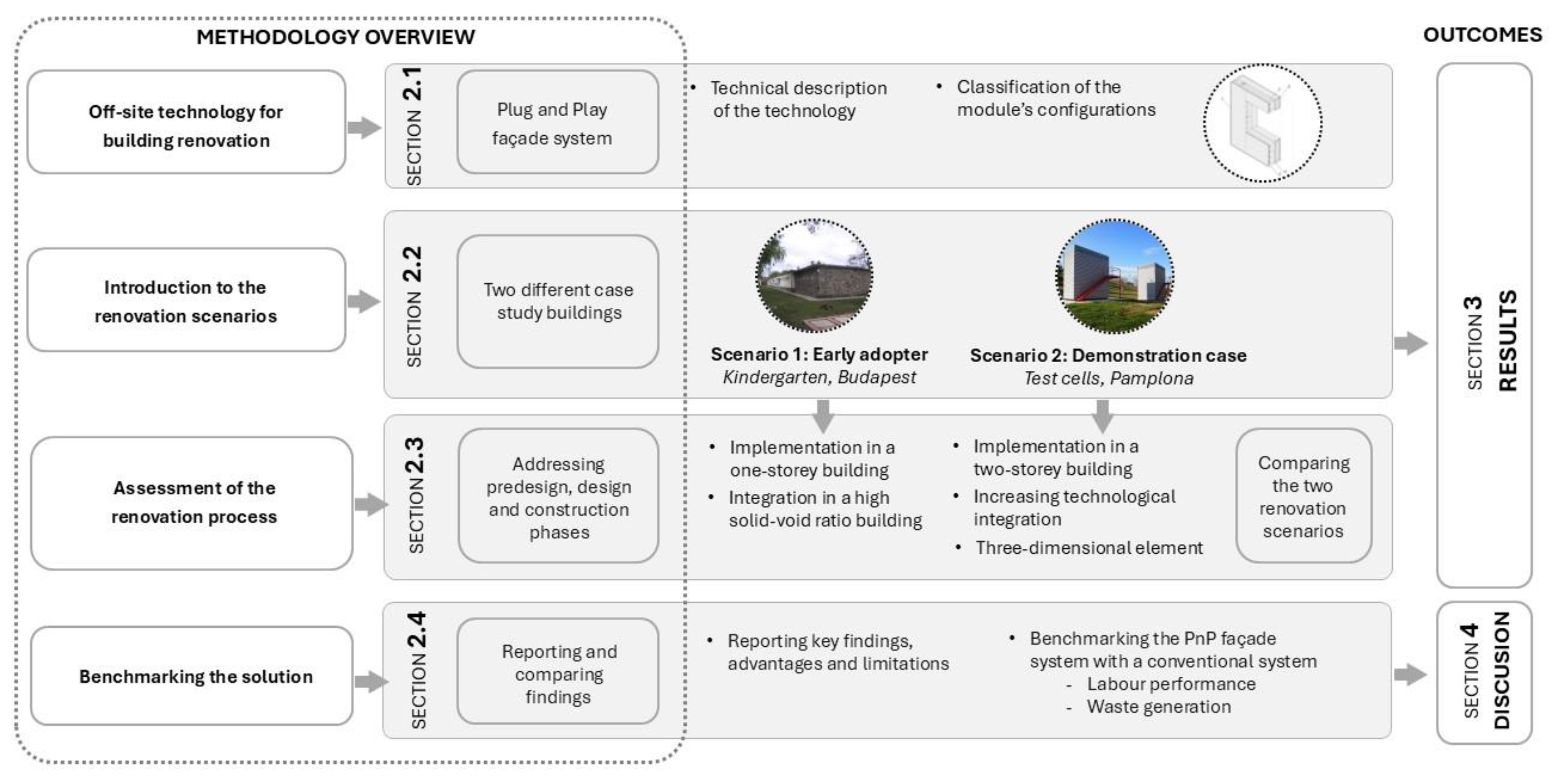
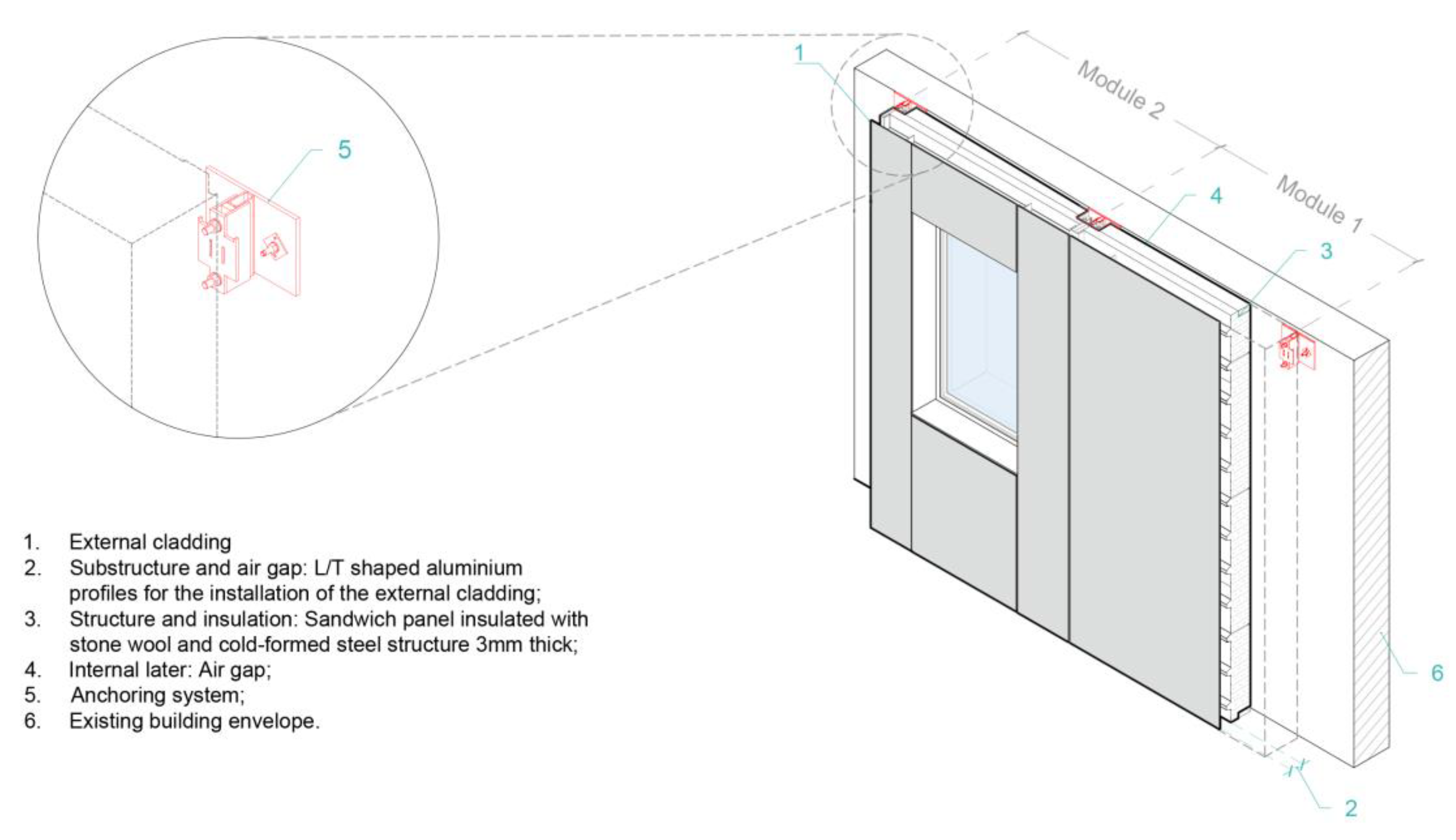





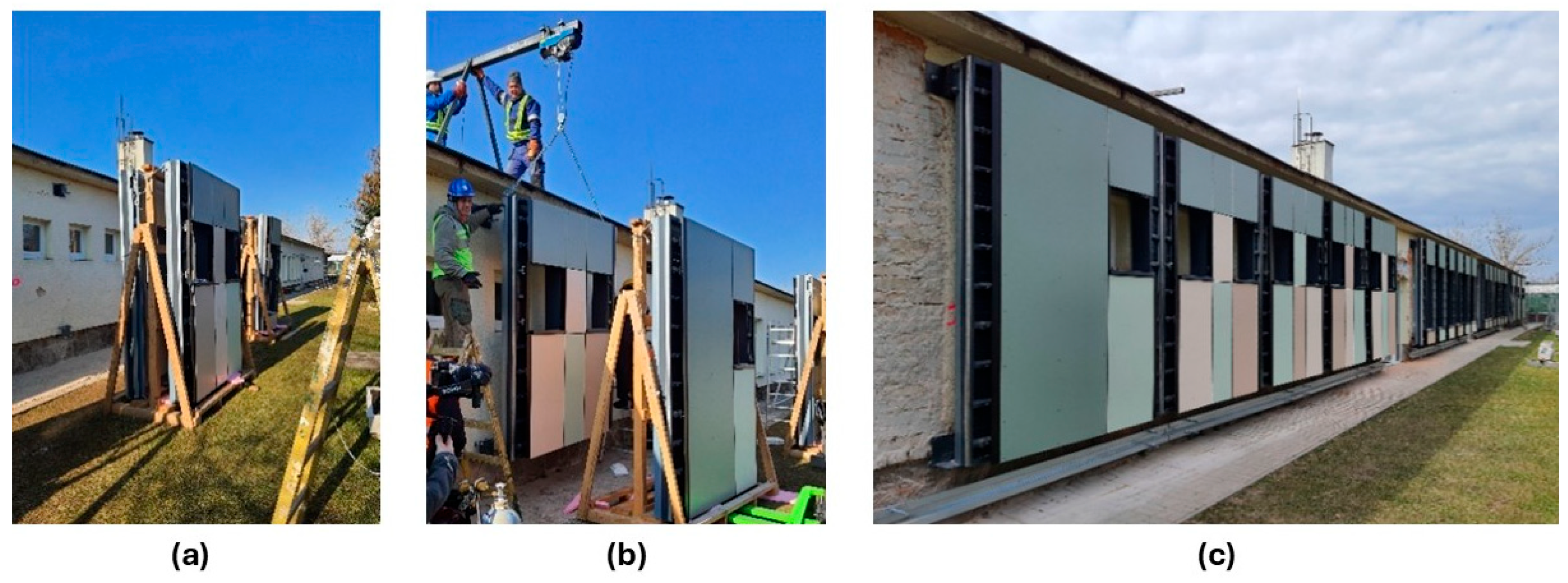




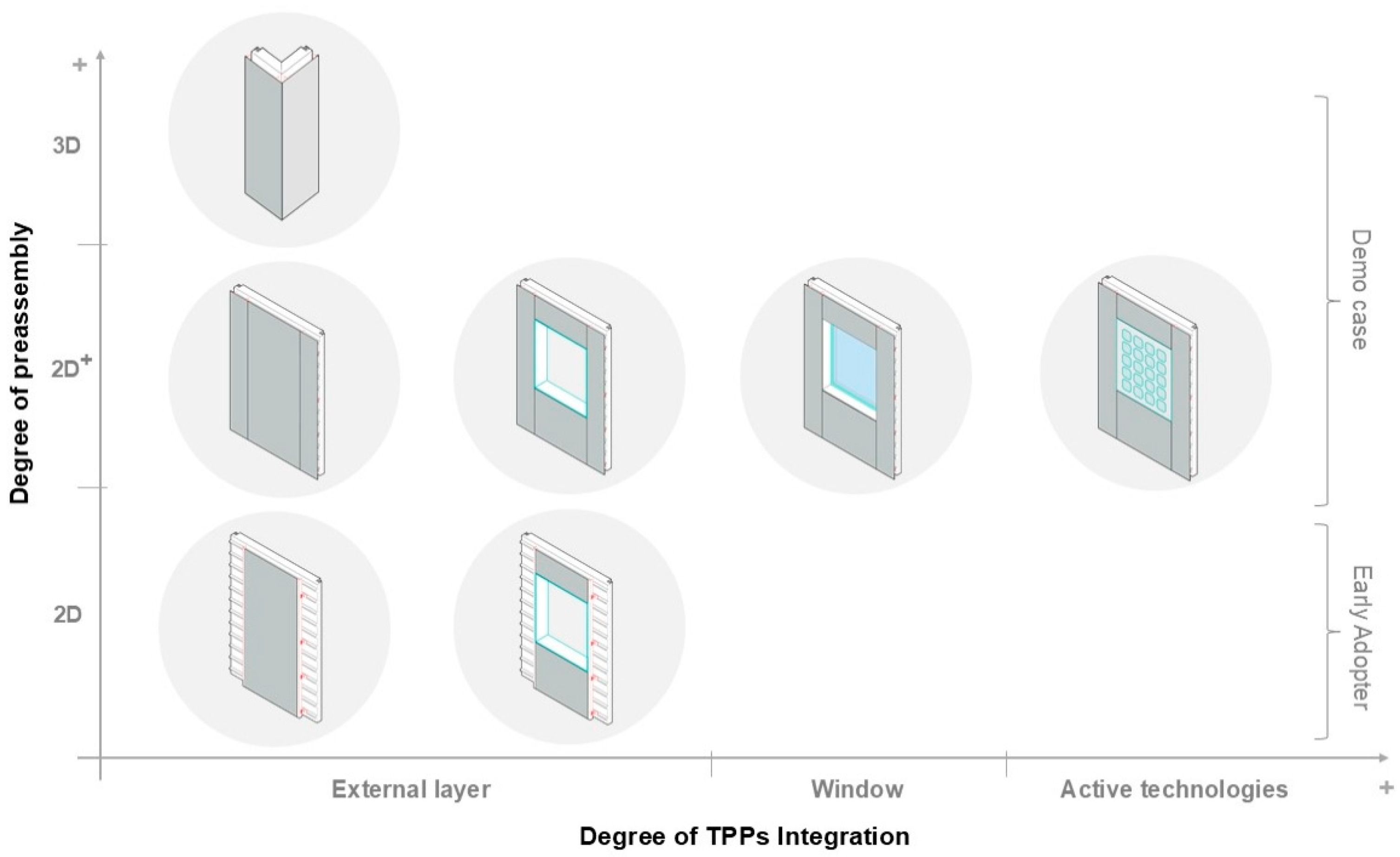
| Configurations | Description |
|---|---|
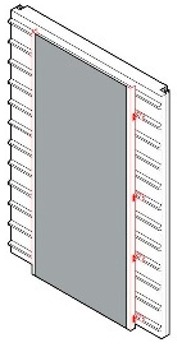 | Opaque module with external layer partially installed Designed to enhance thermal insulation on opaque portions of the building envelope. The edges are left without the external layer installed after adjacent panels are placed to integrate pipes or services within the ventilated cavity and facilitate inspection or adjustments at PnP module joints. However, additional time needs to be considered before completing the external finishing. This configuration also reduces the number of vertical joints in the exterior façade finish. |
 | Opaque module with external layer completely installed This module features a fully assembled external layer for rapid installation and immediate thermal insulation improvement. The feature eliminates the need for on-site operations on the finishing; however, for any inspection of the PnP modules’ joints, the panels at the edge of each PnP module must be removed. |
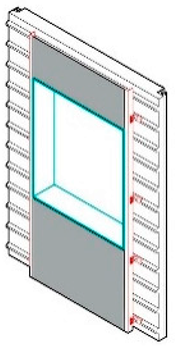 | Holed module without integrated window This module is designed for installation in correspondence with existing facade windows. It is particularly suitable for renovation projects where window systems have either been replaced or are planned for future replacement. Sealing between the existing window and the module’s opening is crucial, as misalignments can lead to poor performance or require on-site adjustments. |
 | Holed module featuring an integrated window This module ensures the continuity of the envelope, integrating a window frame directly into the sandwich panel layer. Factory-installed windows ensure quality, enhancing thermal insulation and weatherproofing performance. However, on-site installation of a perimeter frame from the interior is required to seal the air gap between the existing building’s window opening and the PnP module, ensuring airtightness and optimal performance. |
 | Module with integrated Photovoltaic Panel This module includes the off-site installation of a PV panel, which provides integration with active technologies. Although the module is assembled off-site, on-site procedures are required to establish the electrical connections for each panel or a series of panels to the electrical infrastructure of the photovoltaic system. |
 | Three-dimensional module for building’s corners This module has been designed to address both the architectural and technical challenges of building corners. It provides seamless integration with adjacent modules, ensuring the continuity of the envelope. The module is dimensioned based on the anchoring system’s dimensions, easing the installation process; however, the anchoring system’s installation requires precision to allow the installation. Moreover, the module can be adjusted out of plane consistently on each façade, but it remains fixed and immovable along the longitudinal direction of each façade. |
| PnP Module’s Features | Scenario 1 |
|---|---|
| Width dimensions | 1350–2100 mm |
| Height dimension | 3000 mm |
| Total thickness | 280 mm |
| Weight | 200–400 kg/module |
| Sandwich panel thickness | 170 mm |
| Sandwich panel U-value | 0.24 W/m2K |
| Sandwich panel sound insulation | Rw = 33 dB |
| SP fire performance (EN 13501-1) [55] | A2 s1 d0 |
| PnP Module’s Features | Scenario 2 |
|---|---|
| Width dimensions | 1800–2100 mm |
| Height dimension | 2435–2600 mm |
| Total thickness | 282 mm |
| Weight | 200–300 kg/module |
| Sandwich panel thickness | 150 mm |
| Sandwich panel U-value | 0.28 W/m2K |
| Sandwich panel sound insulation | Rw = 33 dB |
| SP fire performance (EN 13501-1) | A2 s1 d0 |
| Features | Scenario 1 | Scenario 2 |
|---|---|---|
| No. of panels installed | 48 | 36 |
| Area covered with PnP system | 320 m2 | 114 m2 |
| Width dimensions | 1350–2100 mm | 1800–2100 mm |
| Height dimensions | 3000 mm | 2435–2600 mm |
| PnP modules’ total thickness | 280 mm | 282 mm |
| PnP modules’ weight | 200–400 kg/module | 200–300 kg/module |
| SP insulating material | Mineral wool | Mineral wool |
| Scenario 1 Early Adopter Building (320 m2) | Scenario 2 Demonstration Case (114 m2) | |||||
|---|---|---|---|---|---|---|
| Work Breakdown Description | No. of Workers per Day | Days | Total Working Hours * | No. of Workers per Day | Days | Total Working Hours * |
| Preliminary works phase | ||||||
| 5 | 5 | 200 | 4 | 1 | 32 |
| 7 | 5 | 280 | 4 | 1.43 | 45.75 |
| 7 | 3 | 168 | 4 | 0.18 | 5.75 |
| 13 | 648 | 2.61 | 83.5 | |||
| PnP modules installation phase | ||||||
| 2 | 44 | 704 | 4 | 3.84 | 122.75 |
| 7 | 24 | 1344 | 4 | - | - |
| 7 | 16 | 896 | 4 | 5.88 | 188 |
| 3 | 10 | 240 | 4 | - | - |
| 3 | 10 | 240 | 4 | 0.5 | 2 |
| 104 | 3424 | 9.71 | 310.75 | |||
| Adjustments phase | ||||||
| 7 | 8 | 448 | 4 | 0.43 | 13.75 |
| 7 | 1 | 56 | 4 | 0.03 | 1 |
| 7 | 1 | 56 | 4 | 0.23 | 7.5 |
| 10 | 560 | 0.66 | 21.25 | |||
| Summary | ||||||
| Total construction time | 127 | 4632 | 13 | 416.5 | ||
| Opaque Surface | Opaque Corners Surface | Windows | Photovoltaic Panel | |
|---|---|---|---|---|
| PnP modules (n°) | 20 | 16 | Included | Included |
| Constructive element surface (m2) | 87.1 | 24.5 | 2.4 | 2 * |
| Opaque Surface | Opaque Corners Surface | Windows | Photovoltaic Panel | |
|---|---|---|---|---|
| Working item | ||||
| 1. Mineral wool exterior insulation installation | 1.2 | 1.425 | - | - |
| 2. Ventilated façade substructure + external layer installation | 2.35 | 3.25 | - | - |
| 3. Window installation | - | - | 1.25 | - |
| 4. Window frame installation | - | - | 1.35 | |
| 5. PV module installation in façade | 3.43 | |||
| Labour Performance (h/m2) | 3.55 | 4.675 | 2.6 | 3.43 |
| Conventional Construction | PnP Module | Labour Performance Reduction | |||
|---|---|---|---|---|---|
| System | Estimated Time (h) | Database Ratio (h/m2) | Recorded Time (h) | Calculated Ratio (h/m2) | PnP Compared with Conventional |
| Opaque module | 309.2 | 3.55 | 237 | 2.72 | −23.35% |
| Window | 6.24 | 2.6 | included | 0 * | −100% |
| Photovoltaic installation | 6.86 | 3.43 | included | 0 * | −100% |
| Three-dimensional module (corner) | 114.54 | 4.675 | 66.7 | 2.7 | −42.25% |
| Summary | 436.84 | 3.56 | 310.75 | 2.72 | −23.52% |
| Group | Material | LoW Code | Conventional Ventilated Façade | PnP Façade | Waste Reduction |
|---|---|---|---|---|---|
| Waste Packaging (kg) | Plastic packaging | 15 01 02 | 35.6 | 15.3 | −57% |
| Wooden packaging | 15 01 03 | 41.67 | 50.44 | +17% | |
| Paper and cardboard packaging | 15 01 01 | 8.26 | 0 | −100% | |
| Construction and Demolition Waste (kg) | Insulation materials | 17 06 04 | 61.608 | 0 | −100% |
| Mixed construction and demolition wastes | 17 09 04 | 114.24 | 0 | −100% | |
| Aluminum | 17 04 02 | 6.885 | 14.4 | +52% | |
| Plastic | 17 02 03 | 5.5 | 0 | −100% | |
| Wood | 17 02 01 | 5.50 | 0 | −100% |
Disclaimer/Publisher’s Note: The statements, opinions and data contained in all publications are solely those of the individual author(s) and contributor(s) and not of MDPI and/or the editor(s). MDPI and/or the editor(s) disclaim responsibility for any injury to people or property resulting from any ideas, methods, instructions or products referred to in the content. |
© 2025 by the authors. Licensee MDPI, Basel, Switzerland. This article is an open access article distributed under the terms and conditions of the Creative Commons Attribution (CC BY) license (https://creativecommons.org/licenses/by/4.0/).
Share and Cite
Marrone, G.; Masip Vilà, D.; Rafols Ribas, I.; Lupi, M.; Traini, R.; Ibañez-Puy, M. Assessing and Benchmarking a Multifunctional Plug-and-Play Façade for Building Renovation: Advantages and Limitations in the Construction Process. Sustainability 2025, 17, 2153. https://doi.org/10.3390/su17052153
Marrone G, Masip Vilà D, Rafols Ribas I, Lupi M, Traini R, Ibañez-Puy M. Assessing and Benchmarking a Multifunctional Plug-and-Play Façade for Building Renovation: Advantages and Limitations in the Construction Process. Sustainability. 2025; 17(5):2153. https://doi.org/10.3390/su17052153
Chicago/Turabian StyleMarrone, Grazia, David Masip Vilà, Irene Rafols Ribas, Marta Lupi, Rocco Traini, and Maria Ibañez-Puy. 2025. "Assessing and Benchmarking a Multifunctional Plug-and-Play Façade for Building Renovation: Advantages and Limitations in the Construction Process" Sustainability 17, no. 5: 2153. https://doi.org/10.3390/su17052153
APA StyleMarrone, G., Masip Vilà, D., Rafols Ribas, I., Lupi, M., Traini, R., & Ibañez-Puy, M. (2025). Assessing and Benchmarking a Multifunctional Plug-and-Play Façade for Building Renovation: Advantages and Limitations in the Construction Process. Sustainability, 17(5), 2153. https://doi.org/10.3390/su17052153










